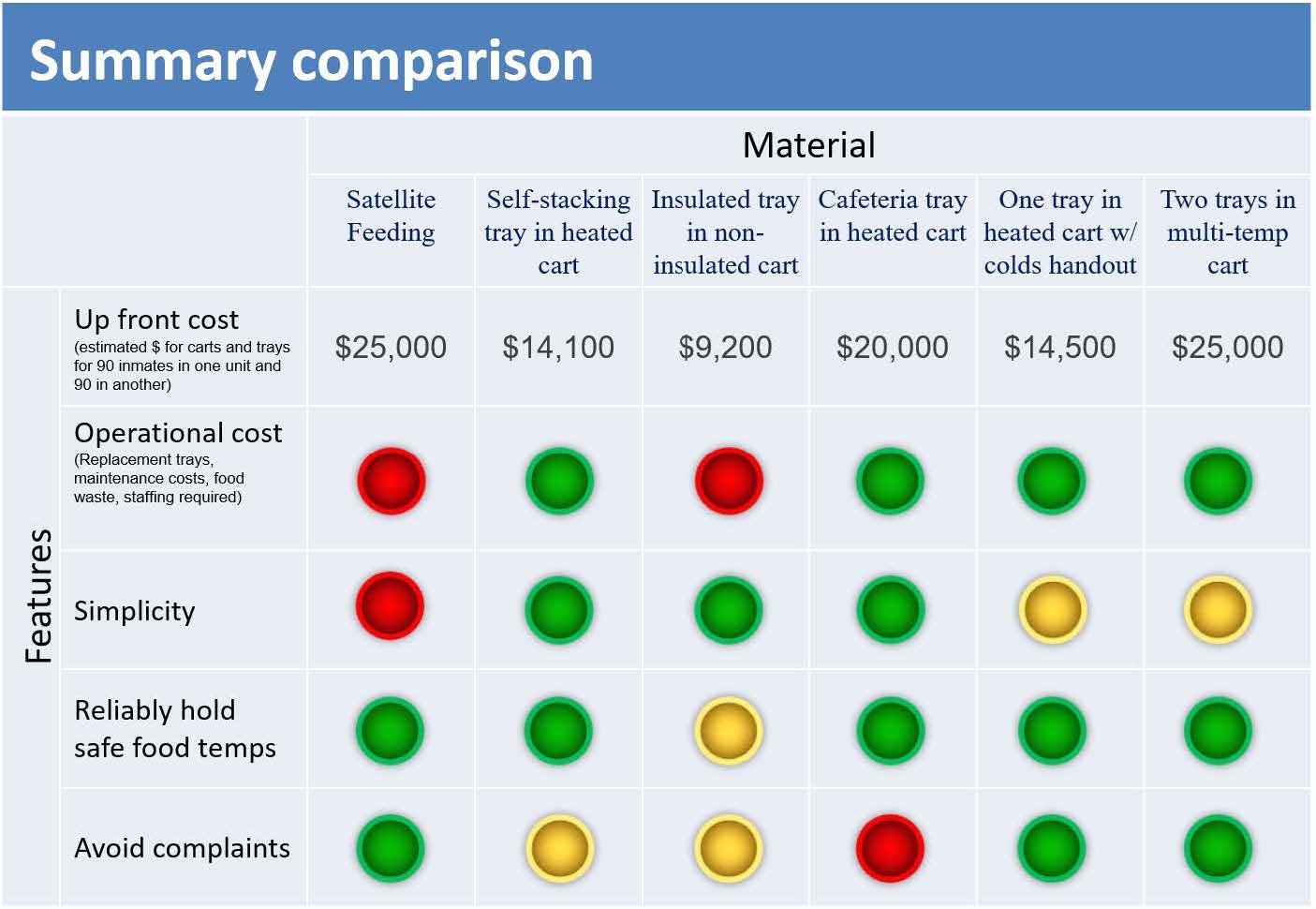The 6 Main Correctional Meal Delivery Systems
What’s the “best” way to deliver meals to housing units? That’s the wrong question. The right question is “What’s the best way to deliver meals to housing units at my facility?” for the problems that I need solved, for the number of inmates I serve, for the distances I transport the meals, for the budget that I have, for the priorities important to my warden/sheriff, for the… you get the point. It would help to know what the options are and their advantages and disadvantages. In this paper you’ll find a brief synopsis of the 6 main methods and their pros and cons. The summary at the end of this paper concludes with a matrix to use for comparison.
So how are my peers delivering meals from a central kitchen to the inmate housing units? Of course, there are many more methods used than what we will cover here and a multitude of variations on the many methods. The intent of this paper is to discuss only the 6 most commonly used methods.
Reasons for feeding in the housing unit:
Why are the meals brought to the inmates in their cells, or cell block commons area, instead of the inmates going to a mess hall? Many institutions including most local jails don’t have a mess hall, so feeding in a cafeteria isn’t even an option. But even where there is a mess hall, the trend in corrections is to discontinue its use and transport meals directly to the housing units. As inmates are classified into risk groups, the higher-security group will almost automatically have the meals brought to their housing unit. However, more and more, the medium-security group is converting to this method as well. The 2 main factors contributing to this type of change are:
1. The need to increase security and inmate control. In any corrections environment, the idea of congregating all or many of the inmates in one place introduces risk; risk of violence, risk of contraband trade, risk of property damage, risk of litigation, etc. That risk is better managed in the controlled environment of the housing unit.
2. The need to reduce security staffing requirements. As budgets get slashed, we have to do more with less. If you go through the process 3 times a day of shuffling inmates to a new room where they are all together, you will have to devote additional security measures and resources. This is low hanging fruit when it comes to opportunities to cut costs to fit the new budget.
So let’s get into it. Feeding in the housing unit goes by many names, but here we will call this “segregated feeding”.
There are six general methods for segregated feeding:
1. Satellite Feeding
2. Self-stacking tray
3. Insulated tray
4. Whole meal in one tray in heated cart
5. One tray in heated cart with colds handout
6. Two trays in multi-temp cart
1. Satellite Feeding
Bulk food transported to remote small serving lines at each of the housing units. Then the trays are made up there from those serving lines.
With this method, the food is prepared in bulk batches and placed in 12” x 20” line pans (typically 4” deep). The bulk pans are loaded into a cart and pushed to the housing unit. The line pans are placed in the remote steam table that is used for the serving line. The inmates come through the line and get their made-up tray and take it to a table in the day room or to their cell. This is similar to having mini mess halls in each housing unit. All the dirty pans and meal trays are loaded back into the cart and taken to the central kitchen for washing.
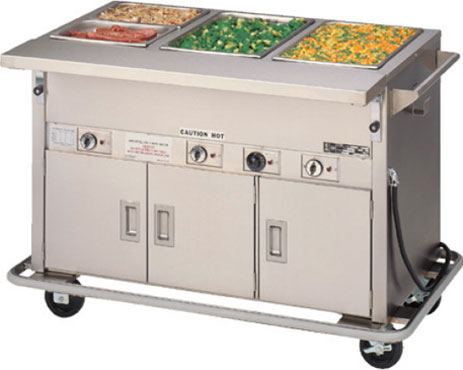
The type of carts used to transport the bulk pans vary depending on the application. For smaller housing units located within a short distance from the production area, normally non-heated, insulated plastic carts or carriers are used. The goal in this case is to go from the large batches (kettle) to handing an inmate a tray within 30 to 45 minutes. For larger housing units and units farther away from the production area, a heated cart is used to transport the bulk food to the housing unit and hold it while waiting to refill the steam table several times as it is being served out. If there isn’t a slot in the steam table for each pan brought, the food is kept warm by plugging in the heated cart that delivered it or by transferring it to a heated holding cabinet that is maintained in the housing unit.
Pros
- Food coming right out of a steam pan and handed to the inmate has the perception of the freshest possible food. This option would likely be the best for morale and satisfaction leading to fewer complaints.
- Maintain hot food temperatures for extended times caused by some sort of unexpected interruption. Minimize complaints. Health code compliance. Food safety.
- No need to mess with tray lids.
Cons
- The inmate sees who he is dishing up food for, allowing discriminatory tray make-up.
- All service ware needs to be transported with the bulk food carriers.
- The equipment and supplies needed to tray up meals is duplicated for every housing unit, increasing the investment and operating costs. Would also need the space for tray make up at each housing unit. Some housing units have a little kitchenette for such purpose.
- Increase maintenance costs to maintain powered equipment.
- The duplicated serving line at each housing unit also multiplies the human resources needed to serve the meal and to supervise those resources.
- It is more difficult to manage portion control with multiple tray lines in multiple locations and with a variation in supervision. This could result in unnecessary shortages.
- When you plan to not be short of food, there is always some food left over in the bottom of the line pan. Now you multiply that left-over amount times number of housing units. Would increase food waste.
2. Self-stacking tray
Tray up meal into one tray, stack the next tray on it to act as the lid, and deliver it to housing unit with an insulated cart or heated cart.
With this method and all following methods in this paper, the tray line is in the central kitchen. As the trays go down the roller conveyer or similar setup, inmates are on each side of the line and put their assigned food item on the tray and passes it to the next person. This kind of tray is typically 5-compartment and all of the food (hot, cold, bread, etc.) is put on the same tray. The last person on the line stacks the tray on top of another tray to act as its lid. Then the top of the stack gets an actual lid.
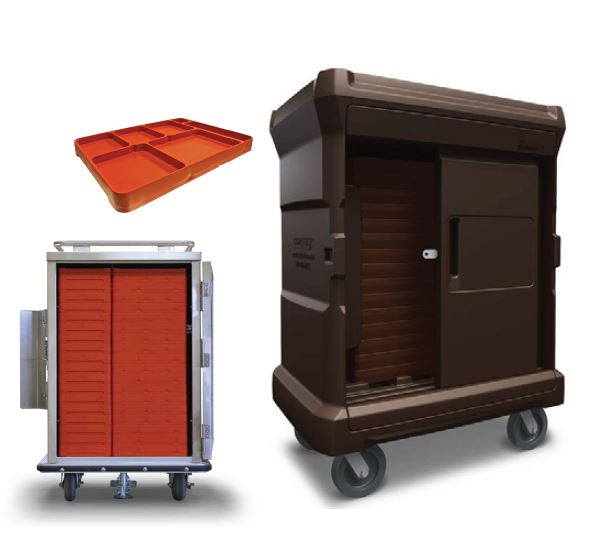
Examples of this type of tray would be SmartTray, Rock or Marathon. These types of trays are not filled with foam insulation and so do not have much insulating properties. To compensate, they are generally delivered in an insulated cart. The goal is to make up the trays in the kitchen and deliver all of them to the inmates within 30 to 45 minutes. In institutions where the food takes longer to deliver, such as many high-population facilities, this would be a challenge so a heated cart is needed (as with section 4. below). Some newer carts on the market are insulated with the ability to add a heating system later if it is determined to be needed. These types of carts can add the heater for all-hot meals and then have it removed for all-cold meals.
When the cart filled with trays gets to the housing unit, each inmate gets handed a tray, the dirty trays are put back in the cart to bring back to ware washing.
Pros
- The whole meal is in one tray and no lid so fewest dinnerware items to track/replace. Very simple method
- Using heated carts, can maintain hot food temperatures for extended times caused by long delivery or caused by some sort of unexpected interruption. Minimize complaints. Health code compliance. Food safety.
- The trays interlock to one another so the stack of trays is highly stable
- These types of trays are typically highly durable and require less replacement than other types
- The trays and corresponding carts are designed to go together and fit a high number of trays per cart. Fewer carts and delivery personnel needed
Cons
- The trays are more expensive than all but insulated trays (section 3. below)
- Some of these trays are heavy and dense and can make a blunt object weapon in the hands of the wrong inmate
- In one tray with no foam insulation between the compartments, the hot food and cold food eventually all become one temperature from bleed through. This could lead to inmate complaints with long delivery time
- Insulated or heated carts, which are needed with this system, are more expensive than open carts or non-insulated carts used with insulated trays
3. Insulated tray on non-insulated cart
Load up meal into one tray, stack the next tray on it to act as the lid, and deliver it to housing unit with an open cart or non-insulated enclosed cart.
This is the most common method for local jails throughout the country, chosen for its simplicity and low overall system cost. It is well-suited for 100 and fewer inmates. Insulated tray systems are commonly the least expensive of all systems. They are very user-friendly, but offer the greatest challenges in delivering food at the required temperature. It has been said that more grievances have been filed for improper food temperatures using insulated trays than any other delivery system. Insulated trays are very dependent on starting food temperature, operator attention to detail, and speed in performing tray make-up and delivery.
This kind of tray can be 4, 5, or 6 compartment and all food (hot, cold, bread, etc.) is put on the same tray. The last person on the line stacks the tray on top of another tray to act as its lid. Then the top of the stack gets an actual lid.
Since these types of trays have foam insulation, they do not have to have an insulated cart to deliver with. Typical open carts are made out of aluminum, have a lower shelf to put most of the trays and use straps to keep the stacks from falling over. The top shelf can be used for drink or other dinnerware items or additional trays. Sometimes, a flatbed type of cart is used with no upper shelf. The goal is to make up all the trays in the kitchen and deliver them all to inmates within 30 minutes. This time might be slightly extended by using an enclosed cart, especially if the cart is insulated. Some institutions use heated carts due to longer delivery times. (see 4. below)
When the cart filled with trays gets to the housing unit, each inmate gets handed a tray, the dirty trays are put back in the cart to bring back to ware washing.
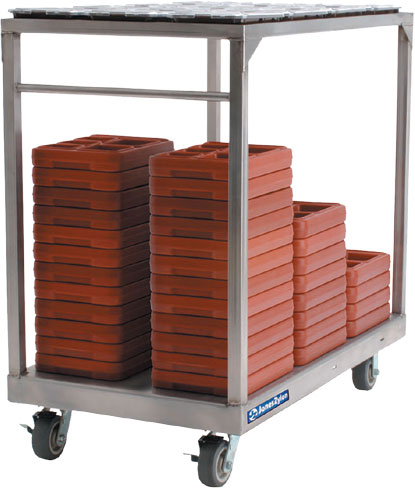
Pros
- The whole meal is in one tray and no lid is needed, so fewest dinnerware items to track/replace. Very simple method
- The trays interlock on one another so the stack of trays is highly stable
- You can use least expensive type of cart to deliver because the trays are the part of the system that hold food temperatures.
Cons
- The trays with this method are rather bulky and so fit a lower number of meals per cart than other methods. Would need more carts and delivery personnel.
- The trays are more expensive than almost all other trays.
- The trays tend to become waterlogged after long-term use. The plastic shell will eventually fracture and the foam interior will soak up water during the washing process. These must be thrown out and replaced
- The length of time that this method can hold food temperatures is rather short, so not much room for interruption in the food service process.
4. Whole meal in one tray in heated cart
Tray up meal into one tray and deliver it to housing units with a heated cart.
This method is more common for larger facilities where the housing units are a good distance from the central kitchen. When the food service takes longer or has the potential to take a longer time, heated carts are used to maintain hot food temperatures. Generally, either an all-hot meal is served using the cart with the heater on or an all-cold meal is served in the same cart with the heater switched off.
To use a heated cart with this single tray system, the choices for trays are the ones described in sections 2. and 3. above that are self-stacking but, more commonly, a less expensive cafeteria tray with a lid is used.
Cafeteria-type trays can be filled, covered with lids, and then stacked in the heated cart. However, they can also be used without lids. For that, heated carts are available with slides for the trays, where a tray is placed as soon as it’s filled. Using lids, however, will help prevent the food from drying out, getting contaminated, or spilling.
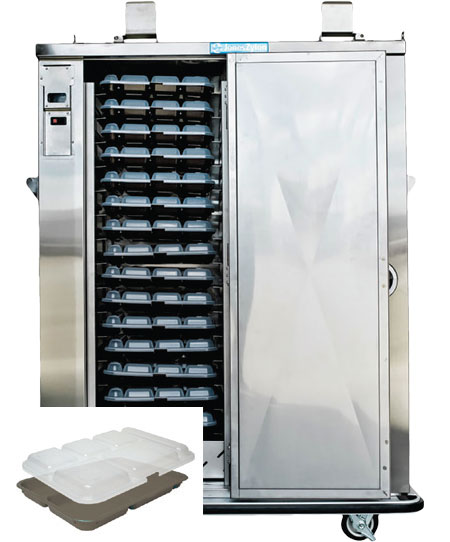
Pros
- The whole meal is in one tray, so fewer dinnerware items to track/replace.
- Maintain hot food temperatures for extended times caused by long delivery or caused by some sort of unexpected interruption. Minimize complaints. Health code compliance. Food safety
- You can use less expensive, standard copolymer trays with heated carts.
Cons
- The trays with this method are rather bulky and so fit a lower number of meals per cart than other methods. Would need more carts and delivery personnel.
- Putting whole meal in a heated cart will warm parts of the meal such as jello, salad, etc. Could lead to inmate complaints. Or you need to manipulate the menu to be all hot or all cold.
- Heated carts have a higher up-front investment.
- Increase maintenance costs to maintain powered equipment.
5. One tray in heated cart with colds handout
Tray up hot portion of meal and deliver it to housing units with a heated cart with cold portion of meal handed out separately.
This method is becoming more prevalent among facilities with very high inmate populations, particularly with high populations in each housing unit. It is a very efficient system to deliver a large number of meals at one time while maintaining hot food temperatures.
In this method, a hot food tray line puts hot food only in a 3-compartment tray, commonly referred to as a “seg tray” or “SHU tray” (that hold between 32.8 and 64 total ounces). Then each tray is lidded and stacked in an all-heated cart. In a separate kitchen station, the rest of the meal is kitted in perforated bags and stacked in a milk crate or box. The crate is transported on the top of the heated cart to the housing unit. At the housing unit, each inmate is given a hot tray and a cold bag. Alternatively, the cold food can be transported in bulk like a box of apples or container of bread on the top of the heated cart and handed out individually.
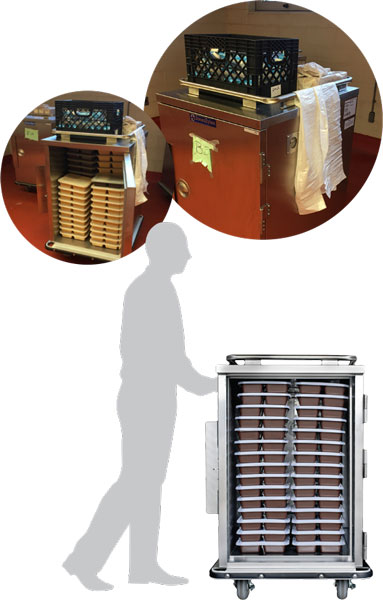
Pros
- Maintain hot food temperatures for extended times caused by long delivery or caused by some sort of unexpected interruption. Minimize complaints. Health code compliance. Food safety.
- You can use less expensive, standard copolymer trays with heated carts.
- Can deliver many meals with one person and a relatively small heated cart. (140 meals in a 30.5”x38” cart that is 47” tall)
- The cold or room temperature food doesn’t get heated.
6. Two trays in multi-temp cart
Tray up hot portion of meal in one tray and cold portion in another tray and deliver it to housing units with a divided cart.
This is the method used by the Federal Bureau of Prisons for meal delivery to the housing units as standard operating procedure. It is also used by larger jails and state prisons where minimizing inmate complaints is a priority.
In this method, a hot food tray line puts hot food only in a 3-compartment tray, commonly referred to as a “seg tray” or “SHU tray” (that holds between 32.8 and 64 total ounces). Then each tray is lidded and stacked in the heated compartment of a dual-temp cart. In a separate tray line, non-hot food and utensils are put in a separate seg tray that is a different color. This tray is lidded and stacked in the ambient or refrigerated side of the same dual-temp cart. At the housing unit, each inmate is given one of each tray, usually without the lids. The dirty trays are put back in the cart and taken to the ware washing station.
One other variation is where a separate cart is used for the cold portion of the meal. Hot trays in an all heated cart and cold trays in an all ambient or refrigerated cart. Some facilities can purchase or are mandated to purchase cold carts from prison industries and can use these carts for that purpose.
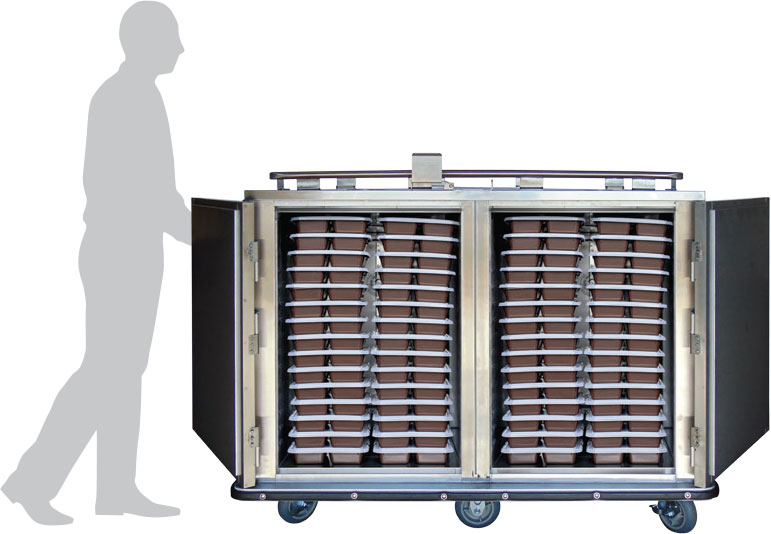
Pros
- Maintain hot food temperatures for extended times caused by long delivery or caused by some sort of unexpected interruption. Minimize complaints. Health code compliance. Food safety.
- You can use less expensive, standard copolymer trays with heated carts.
- The cold or room-temperature food doesn’t get heated.
- Can prevent food safety risks and reduce inmate complaints by refrigerating dairy items, salads/dressings, etc.
Conclusion
As mentioned in the beginning, these 6 methods of correctional meal delivery are not the only methods used. They are the 6 most common. To determine which is best for your facility, you need to weigh the pros and cons of each against the priorities of your operation. See the matrix at the end of this paper to help you evaluate this.
You may see that switching from your current method to a different one would be beneficial. It may have the potential to resolve some persistent problem or grievance that you must constantly battle. It may very well be “the right thing to do” to improve your operation or eliminate risk. However, changing from one system to another is never easy. The fundamentals to change management would apply:
1. Starts at the top. The Warden / Sheriff needs to be the main driving force for the change
2. Involve all stakeholders. All food service personnel and security personnel involved, possibly even key inmates
3. Design it correctly up front. Involve key vendors and perhaps food service consultants. Examples of some of the factors you will want to account for:
- a. What current problems do I want to solve
- b. How many meals need to go to which housing units at the same time
- c. How much time does it take to get to each housing unit
- d. What is the potential for disruption of the meal service and what is my backup
- e. How wide is the most narrow doorway or opening that a cart goes through
- f. Menu schedule. (2 hot meals and 1 cold, all hot, etc.)
- g. Minimum ounces needed for food tray(s) for one meal
- h. How are beverages distributed, and how could they be distributed.
It’s easy to slip into the mode of doing it one way because “that’s the way we’ve always done it”. That’s not necessarily wrong. It’s usually easiest. However, it may be time to tackle a change to the meal delivery method if you have a problem that won’t seem to go away. As they say, the definition of insanity is to keep doing the same thing and expecting a different result.
JonesZylon would be happy to discuss options for your meal delivery process and offer suggestions. We won’t charge you for this and there is no obligation. We’ve been in hundreds of correctional facilities and have practically seen it all. We’d love to help however we can.
 Our Products Are Proudly Made In The USA
Our Products Are Proudly Made In The USA
